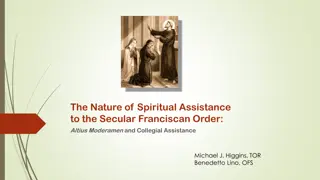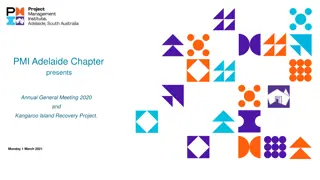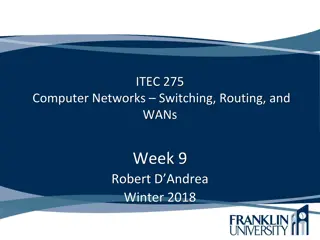Management of Documents and Records in ANS Inspectors Course
In this course, trainees will learn about identifying regulatory documents, oversight document development processes, ICAO SARPS amendment process, principles of records management, storage facilities, and document disposal. The training covers the relevance of documents to the oversight function, good records management principles, and examples of documents and records used in ANS oversight. Technical guidance materials for ANS inspectors are also emphasized.
Download Presentation

Please find below an Image/Link to download the presentation.
The content on the website is provided AS IS for your information and personal use only. It may not be sold, licensed, or shared on other websites without obtaining consent from the author. Download presentation by click this link. If you encounter any issues during the download, it is possible that the publisher has removed the file from their server.
E N D
Presentation Transcript
1 ANS INSPECTORS COURSE
CHAPTER 9 2 Management of Documents and Records
OBJECTIVES 3 At the end of this chapter, the trainees should be able to; 1. Identify different types of regulatory/oversight documents 2. Explain the processes involved in the development and review of oversight documents 3. Appreciate the ICAO SARPS amendment process 4. Explain the principles and importance of good records management 5. Identify different storage facilities and disposal of documents and records
OUTLINE 4 Relevant documents for oversight function Development of Audit/Inspection Documents Reviewing of ANS Inspection Documents
OUTLINE 5 Principles of good records management Records Control and management. Importance of a good filing system Document storage facilities Importance of Securing documents Control and distribution of documents. Disposal of documents and records
Definition Definition of of Terms Terms 6 Document- A piece of written, printed, or electronic material that provides information or evidence or that serves as an official record. Record-An authentic piece of evidence about the past, especially information kept in writing or some other permanent form.
Difference between Documents Difference between Documents and Records and Records 7
Documents Documents for for the the ANS ANS Oversight Oversight 9 Technical guidance material enables ANS Inspectors to perform their safety oversight function in accordance with established requirements and in standardized manner. Includes the provision of technical guidance on the implementation of applicable regulations and instructions. States need to develop and publish their own technical guidance material to assist in the implementing national regulations, procedures and practices.
Documents for the ANS oversight 10 The following reference documents are applicable for ANS Inspectors. ANS Inspectors handbook Advisory circulars Orders ANS Technical standards Applicable forms and checklists State civil aviation regulations covering Annexes 2, 3, 4, 5 10, 11, 12, 15, 19 The Civil Aviation Act/Code Relevant ICAO Documents like , 4444, 10056, 10057, 10066, 8071 etc
Documents Documents Classified Classified as as TGMs TGMs 11 a) Advisory circulars: contain information and guidance material to guide the service providers on the implementation and continued compliance with the Regulations. b) Orders: provide mandatory directions, information and procedures to the Authority s inspectors and officers in undertaking certification, surveillance, audit and regulation enforcement duties
Documents Classified as TGMs 12 c) Inspector s Handbook: guides safety inspectors on the processes, procedures and documentation in the conduct of their oversight activities. d) Technical Standards: developed for the purpose of specifying to ANS Providers the expected level of standards and quality of services. Communicates the regulatory provisions for compliance.
ICAO ICAO Technical Technical Publications Publications 13 ICAO publishes several publications for the purpose of regulating and guiding the aviation industry. These are: - a) International Standards and Recommended Practices (SARPS) Adopted by the Council in accordance with Articles 54, 37 and 90 of the Chicago Convention and are designated as Annexes to the Convention. The uniform application of the Standards is necessary for the safety or regularity of air navigation while the uniform application of the Recommended Practices is regarded as desirable in the interest of safety, regularity or efficiency of air navigation.
ICAO ICAO Technical Technical Publications Publications 14 b) Procedures for Air Navigation Services (PANS) Contain operating procedures regarded as not yet having attained a sufficient degree of maturity for adoption as International Standards and Recommended Practices, as well as material of a more permanent character which is considered too detailed for incorporation in an Annex, or is susceptible to frequent amendment, for which the processes of the Convention would be too cumbersome.
ICAO ICAO Technical Technical Publications Publications 15 c) Regional Supplementary Procedures (SUPPS) have a status similar to that of PANS are approved by the Council, but only for application in the respective regions. d) Technical Manuals provide guidance and information in amplification of SARPS and PANS, the implementation of which they are designed to facilitate. are designed to facilitate implementation and are amended periodically to ensure their contents reflect current practices and procedures.
ICAO ICAO Technical Technical Publications Publications 16 e) Air Navigation Plans detail requirements for facilities and services for international air navigation in the respective ICAO Air Navigation Regions. are prepared on the basis of recommendations of regional air navigation meetings and of the Council action thereon. amended periodically to reflect changes in requirements services. f) ICAO Circulars They make available specialized information of interest to Contracting States. This includes studies on technical subjects. Unlike manuals, circulars are not normally updated.
ICAO ICAO Technical Technical Publications Publications 17 g) Journals. Provide a concise account of the activities of ICAO and to feature additional information of interest to Contracting states and the international world.
Development of Regulatory Documents Development of Regulatory Documents 18 States should develop and implement a process to ensure the timely development amendment of the specific operating regulations, Necessary in order to keep pace with amendments to Annexes to the Convention Sufficient guidance material provides guidance to technical personnel and allows management to ensure that safety oversight functions and activities are carried out in an effective and standardized manner
Development of Regulatory Documents Development of Regulatory Documents 19 The CAA s specific operating regulations should conform with the Annexes to the Chicago Convention; The adoption of requirements shall be as contained in the annexes regardless of the size and complexity of their civil aviation activity; Only non applicable provisions should be avoided;
Development of TGMS Development of TGMS 20 Developed and availed to inspectors to enable them to perform their safety oversight functions effectively and in a standardized manner; Developed immediately after the review and promulgation of regulations; Necessary to subject the draft to stakeholders input before approval.
Importance of reviewing Audit Documents a) minimize risks associated with use of outdated material; b) increase operational excellence; c) ensure that inspectors have the information to do their respective assignments well; d) ensure inspectors are using accurate instructions and procedures; e) boost the Authority s preparedness for USOAP audits by ICAO; and f) comply with international requirements and best practices. 21
Review of ANS Regulations and TGMs 22 It is the responsibility of a State to develop and implement a process to ensure the timely amendment of the regulations and TGMS; specific operating
Review of ANS Regulations and TGMs 23 The regulations may be revised in any of the following circumstances: a) Upon receipt and assessment of amendments to relevant ICAO Annexes and PANS b) Upon amendment to Civil Aviation Act/Code c) Upon receipt of request/information from stakeholders regarding the application and/or implementation of the regulation; d) Whenever there is a significant change in the size and complexity of the aviation system; e) Whenever there is change in technology; f) When the regulations are no longer relevant, applicable or effective; g) As may be desired by the Authority to enhance efficiency of the safety oversight
Review of ANS Regulations and TGMs 24 The TGMs may be amended or revised when need arises owing to the following reasons: a) Upon amendment to Civil Aviation Regulations that require amendment of TGMs; b) Whenever there is an operational or environmental requirement; c) Concern raised by the industry in interpretation and/or accuracy of TGMs; d) Whenever there is a change in technological such as introduction of new equipment e) When it is no longer relevant, applicable or effective.
Maintenance of Documents Maintenance of Documents 25 Robust document control process invariably lies at the heart of any effective safety oversight system; ANS inspectorate documentation required for the conduct of the oversight function A suitable document control procedure must be implemented to define the controls needed to; approve, review, update, identify changes, identify revision status and provide access must control the
Maintenance of Documents Maintenance of Documents 26 Approval of documents prior to issue Review, update and re-approval of documents Identify changes and current document revision status Make relevant documents available at points of use Ensure the documents remain legible and readily identifiable Identify external documents and control their distribution Prevent obsolete documents from unintended use Apply suitable identification if obsolete documents are retained
Principles of good records management Principles of good records management 27 Authenticity Accuracy Accessibility Comprehensiveness Completeness Compliance Effectiveness Security
Records Control and Management Records Control and Management 28 Maintenance of records within the ANS oversight department should be able to facilitate:- a) Identification b) Storage c) Protection d) Retrieval e) Retention f) Disposition
Elements of a filing system Elements of a filing system 29 Suitable file classification scheme - Systematic identification and arrangement File indexes- Key to efficient retrieval File tracking systems- Keep track of movement of files
Importance of a good filing system Importance of a good filing system 30 a) Enables easy retrieval; b) Support operational requirements c) Support policy formulation and administrative decision making. d) Provide continuity of service in the event of disaster. e) Protect the interests of the organization. the legal, accountability and
Importance of a good filing system Importance of a good filing system 31 f) Provide transactions; g) Maintain memory; h) Speed up the efficiency of organization; i) Enhance the process of retirement of records; evidence of business/official the organization s institutional
Choosing storage equipment 32 When choosing suitable storage equipment, the following factors should be considered a) Quantity of the records b) Type, format and media c) Availability of funds d) Availability of space e) Safety Measures f) Simplicity in operating the equipment
Control and Distribution of Documents Control and Distribution of Documents 33 The CAA needs to develop a control procedure and must include the company s processes for the following requirements: a) to approve documents for adequacy prior to issue; b) to review and update as necessary and re- approve documents; c) to ensure that changes and the current revision status of documents are identified;
Control and Distribution of Documents Control and Distribution of Documents 34 d) to ensure that relevant versions of applicable documents are available at points of use; e) to ensure that documents remain legible and readily identifiable; f) to ensure that documents of external origin determined by the organization to be necessary for the planning and operation of the quality management system are identified and their distribution controlled; g) to prevent the unintended use of obsolete documents, and to apply suitable identification to them if they are retained for any purpose;
Disposal of documents Disposal of documents 35 Disposal procedure; Identify the non-essential documents Apply the records and disposal schedule to determine disposal date. Carry out the appraisal exercise Prepare two lists (list of documents to be retained and list of document to be destroyed.) Apply for authority to destroy valueless documents Destroy valueless records using appropriate methods
Disposal Methods Disposal Methods 36 Shredding Pulping Burning
37 Questions and Answer Session
38 END END























